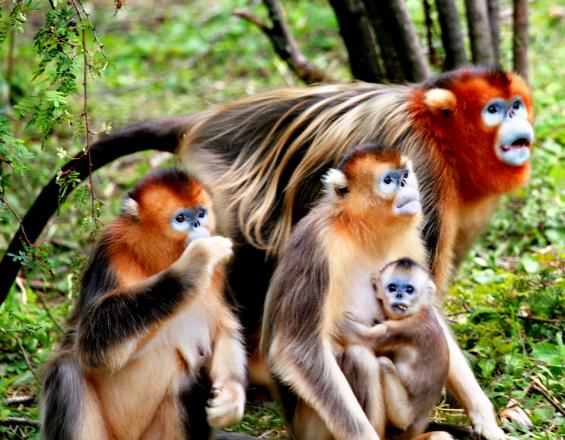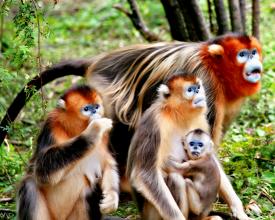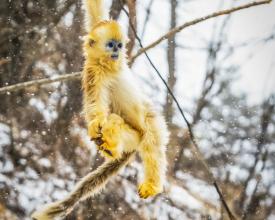
Conservation of the Golden Snub-nosed Monkey on the Basis of Research and Education

For effective protection of the Golden Snub-nosed Monkey and other species, Shennongjia National Park has taken measures of conservation on the basis of research and education. By providing food in the food-scarce winter, the Park attracted a group of monkeys for habituation-based research. The Park built a series of open research platforms (Shennongjia Golden Snub-nosed Monkey Field Research Base of the State Administration of Forestry, etc.), provided sufficient logistical and financial support, and became well-known to the academic community for the research conducted on the park species in cooperation with universities and research institutions. The research achievements have been used for popular science education to promote conservation of the rare and endangered species. The Park built exhibition centers to display images, materials, popular science articles and live video of the species so that the general visitors can see the monkeys without disturbing them.
Context
Challenges addressed
1. The lack of professional research staff.
2. The difficulties in tracking and conducting field survey on the Golden Snub-nosed Monkey.
3. The winter in Shennongjia is cold and long, and the habitat is covered by snow for a long time, causing difficulties in finding food to wild animals including the Golden Snub-nosed Monkey. Artificial food replenishment effectively reduces starvation in winter.
4. Research on key factors such as survival restrictions, evaluation on status quo of the habitat, nutrition, genetic diversity needed to be improved.
5. Low awareness of the general public on the species and its conservation. Some locals didn't even know the existence of such a rare and endangered species. Road construction caused fragmentation of its habitat. Human activites such as logging, grazing, herbal medicine collection, poaching and tourism threatened the species and its habitat.
Location
Process
Summary of the process
Habituation-based research solved the bottleneck problem related to the research on the species. Regarding the field research, there are many difficulties in tracking, conducting identification, nondestructive sampling, non-interruptive observation, etc. A monkey group that is indifferent to human disturbance and can be closely observed is undoubtedly an ideal object for research. The successful habituation perfectly solved the problems and laid the foundation for a research platform. Good research not only attracts attention of higher authorities and the public, bring more financial support for conservation, but also provides good material for popular science education and public awareness.
As an endemic species of China, the Golden Snub-nosed Monkey is favored by researchers, and because it is rare, elegant and beautiful, it is very attractive to the public and the media. Good conservation and research of the species would definitely result in a chain reaction and a virtuous circle of conservation and science research.
Building Blocks
Habituation-based research
Before 2005, the nature reserve was only capable of preliminary research in cooperation with a few institutions and universities. The Golden Snub-nosed Monkey is a species endemic to China favored by researchers, and because it is rare, elegant and beautiful, it is very attractive to the public and the media. Good conservation and research of the species would definitely result in a chain reaction and a virtuous circle of conservation and science research. Based on the experience learned from other protected areas, the Director General decided to establish a special team to track and observe the species around the clock to get first-hand data for further research.
In 2005, the new team started on the long and difficult “monkey-tracking” road with heavy equipment and supplies. With over 400 days of effort, the team successfully reduced a group of monkeys’ natural vigilance against human: they were no longer afraid of the human followers and started to accept the food offered to them in the food-scarce winter. The harmony between human and the monkeys started to grow. Now, this group of monkeys has been indifferent to the activities of the research staff. Abundant data acquired has help researchers learn about the species. This method is called habituation-based research.
Enabling factors
1. A visionary leadship was empowered to decide research direction and budget.
2. Good experience of research were learned from other protected areas.
3. Sufficient funds were provided to support the learning travels and field work of the team.
4. An enthusiastic research team guaranteed the effectiveness of the effort.
Lesson learned
1. At the beginning the research team needs to be small consisting of a few members.
2. The research team needs to be patient, keeping tracking the species and approaching it bit by bit.
3. Once the monkeys become familiar with the team members and find out that they mean no harm, they would start to accept the food given to them and become indifferent to the activities of the team members.
4. Fresh data helps the research team to learn more about the species.
5. Once the trust has been established between the monkeys and the researchers, the researchers can have very close contact with the monkeys (normally twice a day). However, before contacting the monkeys the researchers have to receive disinfection (by walking on a disinfecting mat and through an ultraviolet passage, etc.) and wear disinfected uniform during contact to avoid cross infection.
6. The Golden-snub Nosed Monkey is a very alert species. This habituation-based research method may apply to other wild animal species which are alert and difficult to get close to.
Building a platform for research
The Administration gave priority to the expenses on the conservation of and research on the Golden Snub-nosed Monkey, send its technical staff to attend academic conferences and training courses, held the first National Forum on Conservation and Research of the Golden Snub-nosed Monkey, hosted academic conferences and workshops including the annual meeting of primate experts, and reinforced the communication with the provincial Department of Science and Technology, the provincial Department of Forestry and the State Ministry of Science and Technology, etc. to get more financial and technical support. Since 2007, a series of research platforms have been established, such as the Golden Snub-nosed Monkey Conservation & Research Center of Hubei Province, Shennongjia Golden Snub-nosed Monkey Field Research Base of the State Administration of Forestry, Hubei Provincial Key Lab for Conservation Biology of Golden Snub-nosed Monkey.
Attracted by the research platforms and the promotion by the media, many researchers have swarmed into Shennongjia looking for cooperation in research. The composition and the academic level of the research team as well as its research methods and technology have been significantly improved.
Enabling factors
Giving priority to the expenses on the conservation of and research on the Golden Snub-nosed Monkey, sending technical staff to attend academic conferences and training courses, holding the first National Forum on Conservation and Research of the Golden Snub-nosed Monkey, hosting academic conferences and workshops including the annual meeting of primate experts, and reinforcing the communication with higher authorities to get more financial and technical support.
Lesson learned
To be successful, a research platform has to be attractive, open, sufficiently provided with logistical and financial support, and well-known to the academic community and the general public.
Promotion of public awareness
Since 2006, more than 100 research papers on the Golden Snub-nosed Monkey have been published in academic journals, 30 papers were included in the Scientific Citation Index, and 2 papers were published in the Nature. Five national patents have been acquired, six books have been published, and three achievements have won the provincial award for progress in science and technology.
Every year more than 5,000 university students and researchers visit the Research Base for practice or research. Exhibition centers were built to display images, materials, popular science articles and live video of the species so that visitors can see the monkeys without disturbing them. The species was listed in the Top 10 Animals in the News in 2009, many photos have won domestic and international photography awards, famous documentaries have taken shots in Shennongjia, and dozens of major media companies have released stories of the species.
The locals are now well aware of the importance of the species and human activities threatening the habitat greatly reduced, many locals and visitors have become volunteers, and donations have been received for the conservation of the species. The population of the species and the area of its habitat have significantly increased.
Enabling factors
Publishing research achievements to promote the species and its conservation, inviting media to tell the stories, and use the research achievements for popular science education, to promote the public awareness on the species and its conservation.
Lesson learned
1. Research achievements needs to be transformed into easy-to-understand popular science education materials.
2. The research base should not be open to general tourists. Only researchers, study-tour groups and media staff are allowed to enter the base after disinfection. All visitors should wear disinfected outfit and stay on the trail to keep distance with the monkeys.
3. Visitors whom the monkeys in the base are not familiar with are not allowed to touch the monkeys.
4. The number of visitors must be controlled and they must be required to keep quiet so that the monkeys won't be frightened.
Impacts
The composition and the academic level of the research team as well as its research methods and technology have been improved. This have drawn more attention from provincial and national authorities and won more preferential policies and financial support. Every year more than 5,000 university students and researchers visit the Research Base for practice or research, and the Base is open to study-tour groups of school students and volunteers. The species was listed in the Top 10 Animals in the News in 2009, many photos have won domestic and international photography awards, famous documentaries including Born in China, Wild China, and Seven Planets, One World, etc. have taken shots in Shennongjia, and dozens of national media companies have released stories of the species. It has become a celebrity and Shennongjia is now taking the lead in the popular science education on the species. The research achievements and awareness promotion have greatly helped with proper conservation of the species: the locals are well aware of the importance of the species and human activities threatening the habitat greatly reduced, many locals and visitors have become volunteers and donations have been received for its conservation. The population of the species (about 800 in 2005) has increased to 1,471 and the area of its habitat (143 square kilometers) has expanded to 354 square kilometers.
Beneficiaries
- Shennongjia National Park;
- Science Research Institute of Shennongjia National Park;
- Shennongjia Man and the Biosphere Reserve;
- Shennongjia UNESCO Global Geopark;
- Hubei Shennongjia World Heritage Natural Site
Sustainable Development Goals
Story
Before 2005, the nature reserve was very weak in science research and only capable of preliminary research in cooperation with few institutions and universities. Meanwhile the research for wildlife conservation had developed vigorously in Chinese nature reserves and many success stories had been published. Although Shennongjia is endowed with abundant resources, it remained silent and unknown to the public. Under such conditions, Mr. Liao Mingyao, the Director General of the Administration of Shennongjia National Nature Reserve (integrated into Shennongjia National Park in 2015) decided to do more, with the Golden Snub-nosed Monkey as the breakthrough.
The Director General and his team consulted experts in research institutions and universities, and visited conservation and research organizations in Sichuan, Yunnan and Shaanxi to learn their experience. When he returned, he made a prime but bold decision: establish a special team to track and observe the Golden Snub-nosed Monkey around the clock to get first-hand data of the species. The decision turned out to be wise and far-sighted. As an endemic species of China, the Golden Snub-nosed Monkey is favored by researchers, and because it is rare, elegant and beautiful, it is very attractive to the public and the media. Good conservation and research of the species would definitely result in a chain reaction and a virtuous circle of conservation and science research.
In April 2005, the new team started on the long and difficult “monkey-tracking” road with heavy equipment and supplies. The mountain paths were dangerously steep, the weather was changeable, the primitive forest was dense, and the alert monkeys escaped as soon as they saw a human… There were too many difficulties. With over 400 days of effort, the team successfully reduced a group of monkeys’ natural vigilance against human: they were no longer afraid of the human followers and started to accept the food offered to them in the food-scarce winter. The harmony between human and the monkeys started to grow. Now, this group of monkeys has been indifferent to the activities of the research staff. This method is called habituation-based research.
In 2019, the Administration provided CNY 3 millions (about USD 428.600) to support the field work by top research teams in China, and established a foundation for the conservation of this species and its habitat, which has received donations of CNY 4 million (about USD 571.000).

